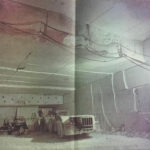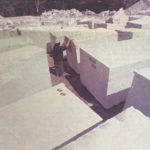By Bruce Edwards
The back road off route 7 winds up the mountain just south of the village of Danby. A small sign that could easily be missed points the way to the destination.
The road passes by a few isolated homes that at one time may have been “company homes.” A little bit farther a turn-off area is covered with crushed marble indicating to the visitor that he is near the end of his journey.
Past the last curve, the narrow two-lane road straightens out and is swallowed up by the side of Danby Mountain.
The former Vermont Marble Co.’s Imperial Danby Quarry is the world’s largest underground marble quarry—a 28-acre cavern that has been in operation since 1906.
The 1-mile long tunnel snakes down some 600 feet into the bowels of the mountain, which is part of what is known as the Shelburne Formation — a 450-million-year-old marble deposit that stretches from the Massachusetts border north to Colchester. The formation is part of an ancient, continental shelf that extended from Georgia to Newfoundland, according to University of Vermont geologist Barry Doolan.
The quarry, with its labyrinth of passageways, is damp and dimly lit. Water from underground springs drips from the ceiling and turns the marble dust underfoot into white mud.
In the distance, the sound of a large flatbed truck echoes off the marble walls and 30-foot-high ceilings as it arrives to pick up a shipment.
A dinosaur-sized forklift with a piercing searchlight moves into place and easily lifts and then plucks down one 45-ton block of marble onto the back of the truck that is bound for the Port of Quebec. The block’s final destination is somewhere in Europe, says quarry master Michael Blair, a 15-year veteran of the quarry.
Along the way into the inner recesses of the mountain, Blair’s four-wheel-drive vehicle stops at a section that resembles a small canyon.
Peering over the edge, one can see that the entire middle section of marble has been removed, leaving only a series of colossal marble columns on either side.
Blair explains that this 150-block section has been earmarked for shipment to Germany.
Inside the mountain, the quarry employs 22 workers on two shifts, a far cry from the days when nearly 200 workers would work around the clock. Today, workers use four different kinds of diamond-tipped saws to cut the stone from the mountain. The saws are cooled with water from underground wells, which is then recycled.
Over at what is called the staging area, blocks are graded according to quality. Each block is stenciled with a number, the date, and section number indicating where the block came from. The top grade can command $40 a cubic foot while lower grade blocks go for $18 a cubic foot.
In another area of the quarry, overall-clad workers with hard hats prepare to separate a block from the marble wall. The sides of the walls are etched with marks showing where previous blocks have been quarried leaving a brick-like impression.
Col. Redfield Proctor’s once might Vermont Marble Co.,which during its peak employed thousands of workers at its mill in Proctor and at its many quarries, closed its doors in February after 123 years in business.
But the company’s most famous quarry got a new life in January after Pluess-Staufer, the Swiss owner, lease the Danby quarry to European Granites Co., a consortium of companies that includes R.E.D. Graniti of Carrara, Italy.
Since that time, the Italian operators of the quarry have increased production while at the same time increasing the quality of the marble quarried. To that end, the new operators have brought in $500,000 in new equipment, according to Livio Zucchini, an official with European Granites who is overseeing the Danby operation.
The quarry’s pristine white marble is considered the finest stone of its kind in the world. It has graced some of the world’s most famous buildings: the U.S. Supreme Court, Jefferson Memorial, the Canary Wharf project in London, the Same Bank in Saudi Arabia, and the Chiang Kai-shek Memorial in Taiwan.
Actually, there are several varieties of Danby marble ranging from the most popular Imperial to Mariposa, a white marble with rich veins of black and grey.
Although in operation for nearly 87 years, there is no fear of running out of precious white stone. Asked about how much marble is left inside the mountain, Blair estimates the quarry will last at least another 100 years.

